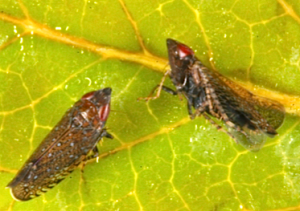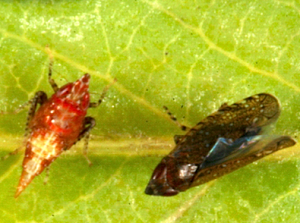The Fruit IPM Report for the week shows an upward trend with more Sharp-nosed Leafhopper (SNLH) adults maturing and moving around fields, making transmission of stunt disease to previously uninfected bushes more likely. This insect in the only regular target for post harvest sprays. Now is an appropriate time to treat.
Sharp-nosed Leafhopper Life Cycle
SNLH feeds and reproduce on blueberry, huckleberry, cranberry, and other related plants. SNLH feeding causes little direct damage but it transmits the phytoplasma that causes stunt disease in blueberries. They are small brown insects with a pointed head (Figure 1). SNLH picks up the disease while feeding on infested bushes and carries it to other plants in subsequent feedings. Usually only adults will carry the disease from plant to plant, since nymphs are wingless and can’t fly (Figure 2). This insect completes two generations in New Jersey. Adults are abundant in the woods, where many alternative hosts are present, and may move to commercial blueberry fields in the spring. Eggs overwinter inside fallen leaves and hatch in mid-May. Nymphs complete 5 instars. Nymphs from the first generation reach adult stage in mid-June, while nymphs from the second generation reach adulthood in early August. Adults move back to the woods in the fall. Monitoring these generations is critical for timing of control strategies.
Monitoring and Control
This insect is the ONLY regular target for post harvest sprays. Adults can be monitored using yellow sticky traps. First generation SNLH is often controlled with sprays targeted for plum curculio, aphids, and cranberry fruitworm. Treatment decisions for the 2nd generation should be based on individual population levels, as well as any history of stunt disease on your farm. Because adults migrate from woods, monitoring should be intensified in, and sprays should be directed to, the perimeter of fields to control migrants carrying the disease. Insecticides are usually applied just prior to peak flight, which will probably be sometime near the end of August to early September (this time of year).
Note that Burlington County farms often have higher populations of SNLH than farms in Atlantic County. In Burlington County with high SNLH populations, treatments may be needed by the middle of the month, and possibly again during the first half of September. If you are in Atlantic County, or have low SNLH populations, then 1 application should be applied late August to early September, if needed.
We recommend use of Assail 30SG @ 3-5 oz, Actara @ 3-4 fl oz, Admire Pro @ 1-1.4 fl oz, Lannate LV @ 1.5 pt, or Malathion LV @ 10 oz per acre. It is also important to remove all plants that show symptoms of stunt disease. Removal of bushes should be done after insecticide treatment to avoid movement of leafhoppers from infested to healthy plants, thereby facilitating spread of the disease.



